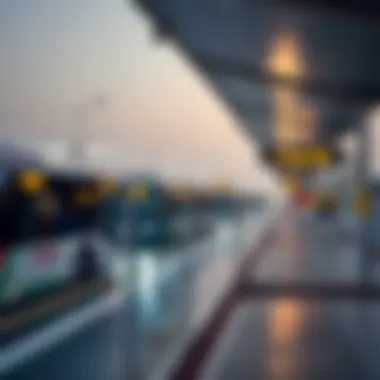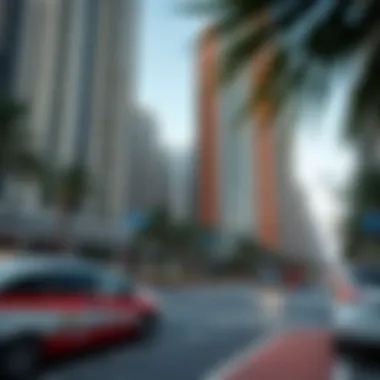Impact of E101 Bus Route on Dubai's Real Estate


Intro
Understanding the evolving landscape of urban transit is vital for anyone investing in real estate, especially in a dynamic city like Dubai. One of the most significant developments in this context is the E101 bus route. This transportation line connects various neighborhoods to key destinations, enhancing accessibility and convenience. The effect goes beyond mere transit; it plays a pivotal role in shaping the housing market and influencing property values across the emirate.
As we navigate through the nuances of the E101 route, we will bring into focus not only how it connects people but also how it catalyzes changes in the residential preferences of homeowners and tenants alike. Today, potential buyers and renters are not just looking for a home; they are searching for a lifestyle. And a critical aspect of that lifestyle is proximity to reliable public transport.
In this detailed exploration, we will look at market insights, including current property trends and investment opportunities linked to the E101 bus route. Additionally, practical tips will shine a light on whether renting or buying is the more suitable option for different types of residents. By the end of this article, stakeholders will be better equipped to understand how a simple bus route can have substantial implications on the real estate sector and the nature of urban living in Dubai.
Overview of the E101 Bus Route
The E101 bus route plays a crucial role in the public transportation network of Dubai, seamlessly connecting various neighborhoods to the bustling heart of the metropolis. Its importance cannot be overstated, as it serves as a lifeline for many residents, commuters, and business travelers alike. The E101 route not only facilitates convenience but also positively influences the real estate landscape in Dubai.
Historical Context of the E101 Route
Before this route existed, travel between pivotal areas of Dubai wasn’t as straightforward. The origins of the E101 can be traced back to a time when public transport options were limited, causing many to rely on personal vehicles, which often led to traffic congestion. As Dubai grew and evolved into a multi-faceted city, the need for effective public transport became paramount. Thus, the E101 was established to cater to the rising demand for accessible routes connecting suburban areas with major commercial hubs. It represents a key development in Dubai’s commitment to enhancing public transport systems while responding to demographic shifts and growth.
Current Route and Coverage
The current layout of the E101 has expanded to cover significant sections of the city, linking areas like Rashidiya and international destinations such as Dubai Airport directly to central districts. The route is designed thoughtfully, ensuring coverage of not only main passenger hubs but also residential enclaves. Riders find stops located near essential services such as malls, schools, and healthcare facilities, enhancing the ease of daily life.
For instance, one could board the E101 at the Al Ghubaiba Bus Station, and without fuss, reach business districts near Sheikh Zayed Road or vibrant neighborhoods like Deira. This thorough coverage gives it a competitive edge in Dubai's transport ecosystem.
Frequency and Schedule
When it comes to frequency, the E101 does an admirable job of accommodating passenger demand. Buses generally run at intervals of around 30 minutes during peak hours and hourly during off-peak times. This makes it convenient not only for those commuting to work but also for tourists and others making their way around the city. Additionally, real-time tracking systems help passengers plan their journeys more effectively, eliminating uncertainty about waiting times.
Public transport in Dubai is known for its punctuality, and the E101 route lives up to this reputation, making it a reliable option for daily travel.
The E101 bus route exemplifies how enhanced connectivity not only transforms how people navigate the city, but also cultivates a richer environment for real estate investment and development.
Station Facilities and Amenities
The E101 bus route serves not just as a means of transportation but as a critical node in the urban fabric of Dubai. The facilities and amenities available at the bus stations play a significant part in shaping the commuter experience and, subsequently, the attractiveness of nearby properties.
Bus Stops and Accessibility Features
Bus stops along the E101 route are designed with both convenience and inclusivity in mind. Strategically located, they cater to a diverse range of commuters—be it locals, tourists, or workers. Key features include:
- Shelters with Seating: Offering shade from Dubai’s intense heat, these shelters provide a comfort zone for individuals waiting for their buses.
- Digital Displays: Real-time information on bus arrivals keeps commuters well-informed, reducing uncertainty and enhancing the overall travel experience.
- Accessibility Options: The bus stops are equipped with ramps and tactile paving for individuals with disabilities, facilitating easy access.
These accessibility features ensure that the E101 route is viable for everyone, promoting a more inclusive environment which, in turn, can influence property desirability in the vicinity.
Nearby Services and Landmarks
The significance of nearby services and landmarks cannot be overstated. Living within close proximity to bus stations with surrounding amenities can substantially bump up property value. The E101 route is accessible to numerous essential services and attractive landmarks, offering substantial appeal to residents. Consider the following:
- Educational Institutions: Schools and universities located near bus stops make them appealing to families and students alike. Proximity to these institutions is often a key consideration in property purchasing decisions.
- Shopping Centers: Malls and local markets close to the route ensure that residents do not have to travel far for their daily needs. Having a supermarket down the road improves the overall quality of life, making properties more desirable.
- Recreational Areas: Parks and community centers near the E101 are a major draw for families and fitness enthusiasts. Being close to such spaces can significantly enhance the livability of an area, hence affecting its real estate market positively.


Integration with Other Transport Systems
The efficiency of public transport is greatly enhanced by its integration with other systems. The E101 bus route offers seamless connections to the metro, taxis, and even ride-sharing platforms:
- Metro Stations: Having direct connections to major metro stations increases the utility of the E101 route, allowing commuters to transfer easily between modes of transport. A potential homeowner will look favorably on properties with quick access to the metro network.
- Taxi Hubs: Close proximity to taxi hailing areas adds another layer of convenience, making it easier for commuters who prefer private transport when needed.
- Ride-sharing Services: The rise of ride-sharing apps has changed the commute landscape. The integration of these services with bus stops means that commuters have options, creating a more adaptable transport ecosystem.
The strategic placement of the E101 route, replete with these facilities and integrations, not only elevates commuting ease but significantly shapes local real estate trends, making it a focal point for potential homebuyers and investors.
Real Estate Market Insights
The E101 bus route, threading its way through Dubai, serves as much more than just a transportation line; it is a significant player in shaping the real estate landscape of the area. Connecting various neighborhoods and commercial hubs, the route brings a unique vantage point on how effective transit systems can alter property dynamics, influence buyer perceptions, and even dictate the pace of urban development. Real estate market insights on the E101 route cover a range of factors, presenting a multifaceted view critical for homeowners, tenants, real estate agents, and investors alike.
Impact on Property Values
The introduction and enhancement of public transport facilities can significantly influence property values along the E101 route. Properties that are located near bus stops or along major transit corridors can see uplift in their prices. It’s common to observe a trend where homes positioned within a 10-minute walk from a bus stop have higher market values compared to those situated farther away. This scenario holds especially true in Dubai, where accessibility is a cornerstone of real estate desirability.
For instance, residential communities near the E101 have experienced gradual value increases, often exceeding those of similar properties in less accessible areas. Investors often need to be aware of such dynamics, considering that the long-term viability of investments can hinge on their proximity to integrated transport systems. Moreover:
- Convenient access to work and amenities leads to higher demand for properties in the vicinity.
- Perceived value rises as potential buyers prioritize locations connected by efficient public transport, aligning with modern urban living standards.
- Rental yields are often enhanced, reflective of the ongoing demand for easily accessible housing options.
"Proximity to public transit is no longer just a bonus; it's a primary expectation among potential homeowners in Dubai's evolving market."
Residential Preferences Along the Route
The E101 route paves the way for notable shifts in the residential preferences of potential tenants and buyers. In an age where convenience is king, many individuals are evaluating not only the property itself but how easily they can reach their places of employment or study. The bus route's coverage creates a more appealing living situation, leading many to prefer apartments and houses located nearby.
Young professionals and families alike are drawn to neighborhoods serviced by the E101for several reasons:
- Access to schools, supermarkets, and recreational facilities promotes a quality lifestyle.
- The ability to bypass traffic jams creates an invaluable time-saving measure, especially during rush hours.
- Therefore, areas with efficient bus access witness increased interest from renters looking for short-term leases or families planning to settle down.
The influence of the E101 on where people choose to live has implications for urban planning and development as well. As demand surges for residential projects along the route, developers can strategically position new constructions to fully capitalize on these changing preferences.
Investment Opportunities in Proximity to E101
For investors keeping an eagle eye on Dubai’s dynamic property market, the area surrounding the E101 bus route offers a variety of opportunities worth exploring. High appreciation potential can be observed here:
- Commercial Properties: The increased foot traffic from commuters creates perfect circumstances for businesses, making investment in retail or office spaces an attractive option.
- Residential Developments: With rising demand from families and young professionals, constructing residential complexes close to bus stations is likely to yield high returns.
- Mixed-Use Developments: Investing in properties that combine residential and commercial spaces can be particularly lucrative, as it caters to a diverse array of tenant needs and maximizes the convenience factor.
Overall, investors may find substantial value in areas served by the E101, as it nurtures a booming rental market and aids the upward trajectory of property values. With the E101 enhancing connectivity, it presents a golden opportunity for those willing to tap into the evolving demand for accessible and vibrant neighborhoods in Dubai.
Social and Economic Impact
The E101 bus route isn't just a line on a map; it weaves a narrative that shapes the social and economic fabric of Dubai. By connecting diverse communities and facilitating access to resources, employment, and leisure, this route plays a pivotal role in enhancing life for residents. In this section, we will explore how the E101 influences community connectivity, supports local businesses, and fosters growth in emerging neighborhoods.
Enhancing Community Connectivity
The heartbeat of any city lies in its connectivity. The E101 bus route serves as a lifeline, bridging gaps between neighborhoods and enabling individuals to navigate effortlessly across various parts of Dubai. The key benefits of this enhanced connectivity are manifold:


- Access to Services: With numerous stops along the way, residents can easily reach educational institutions, healthcare facilities, and retail spaces. This access is particularly significant for those who rely on public transport, including students and professionals.
- Social Integration: The route facilitates a melting pot of cultures. People from different walks of life interact, promoting social cohesion and integration. Regular commuters develop familiarity and camaraderie, which enriches community ties.
- Civic Participation: Improved transport accessibility encourages greater participation in community events and local governance. Residents are more likely to engage in local forums, impacting decision-making that affects their quality of life.
"Public transport acts as the glue that binds a community together, promoting not just movement, but social sharing and togetherness."
Effect on Local Businesses
For local businesses, proximity to the E101 bus route can be a game-changer. Storefronts located near bus stops often enjoy higher foot traffic, which directly translates to increased sales. Some key aspects include:
- Increased Customer Base: Accessibility attracts a broader demographic, including those who might not typically frequent the area. As the bus route brings in new customers, businesses can expand their offerings or operating hours to cater to increased demand.
- Brand Visibility: Establishments situated along the E101 benefit from consistent exposure. Commuters notice these businesses regularly, which increases brand awareness, making it more likely for potential customers to stop in.
- Collaborative Growth: Local businesses can band together for promotions, drawing in commuters, and encourage repeat visits. A neighborhood with a thriving business ecosystem can foster local loyalty.
Fostering Growth in Emerging Neighborhoods
As the E101 bus route expands its reach, it brings new life to previously underdeveloped areas, paving the way for urban growth. Key factors contributing to this phenomenon include:
- Real Estate Development: Increased connectivity attracts developers eager to invest in property, leading to new residential and commercial developments. This creates job opportunities, fostering economic growth in the vicinity.
- Urban Revitalization: Emerging neighborhoods often experience revitalization as transport improvements attract new residents and businesses. The presence of the E101 can catalyze infrastructure upgrades and beautification projects, enhancing overall quality of life.
- Commuter Preferences: The route offers a significant advantage for potential property buyers and renters. Areas along the E101 may see a rise in demand as commuters seek convenience and accessibility, driving up property values.
In summary, the E101 bus route serves as an engine for social and economic transformation in Dubai. By enhancing community connectivity, bolstering local businesses, and fostering growth in emerging neighborhoods, it has become a crucial element in the city’s ongoing evolution. Understanding these dynamics aids investors, homeowners, and residents in grasping the far-reaching implications of urban transport systems.
Future Developments Along the E101 Corridor
As Dubai continues to evolve, the E101 corridor stands poised to become a focal point for future developments. This section encapsulates the visionary urban landscape that is taking shape along the route and evaluates how these advancements can enhance both connectivity as well as the local real estate market.
Urban Development Plans
Urban development along the E101 is not just about constructing more buildings; it's a holistic vision that combines residential, commercial, and recreational spaces. Notable plans have been set in motion to transform underutilized areas into vibrant hubs. The development blueprint emphasizes public spaces, with parks and pedestrian-friendly walkways designed to create a sense of community.
In addition, the government's push for smart city initiatives has led to the incorporation of green technologies in many of these projects. For instance, energy-efficient systems are prioritized in new properties, and there’s a significant focus on sustainable architecture. These modern designs foster a more appealing environment, attracting a diverse demographic, thereby enhancing property values and promoting a desirable lifestyle.
Public Transport Enhancements
The integration of enhanced public transport options along the E101 corridor is another key aspect of its future developments. Plans are underway to increase bus frequencies, improve the overall service quality, and introduce more user-friendly technologies. This includes real-time tracking apps and updated schedules, making commuting smoother for residents and visitors alike.
In addition, there are proposals to establish connections with the metro system and other bus routes, which would serve to create a more cohesive transit network. By providing seamless transfer points, daily commuters will benefit, reducing travel times significantly. This transit-oriented development is crucial not just for convenient daily travel, but it also appeals to investors by increasing the attractiveness of properties situated near these public transport enhancements.
Sustainable Urban Living Initiatives
Sustainable urban living initiatives along the E101 corridor are gaining traction as Dubai aims to lead in eco-friendly practices. Emphasis is placed on creating eco-efficient communities that prioritize sustainability without compromising on modern conveniences. For example, developers are looking at implementing rainwater harvesting and renewable energy sources in their projects.
Furthermore, initiatives geared towards promoting cycling and walking ensure that the corridor is not solely car-dependent. Plans for bike lanes and shaded pathways are being drawn up, which align well with Dubai’s ambitious vision for reducing its carbon footprint. Such developments not only fall in line with global sustainability goals but also enhance the quality of life for residents and create a market that appeals to environmentally-conscious buyers.
Investors should pay close attention to these evolving dynamics, as they can substantially influence property values in the area.
In sum, the upcoming projects along the E101 corridor present an exciting opportunity for real estate stakeholders. By fusing urban development, public transport enhancements, and sustainability initiatives, this region is heading towards a promising future. Such progress is bound to impact real estate trends, guiding investors and homeowners in their decision-making processes.
Comparative Analysis with Other Bus Routes
When exploring the E101 bus route, it’s vital to understand its position within Dubai’s broader public transport network. This comparative analysis serves as a means to highlight the E101's distinct characteristics and how it stands against other major routes. By looking at these elements, readers can appreciate the unique benefits and challenges that the E101 presents to both travelers and investors.


E101 vs Other Major Routes
In considering the E101 route, one should not overlook its competition, such as the E10 or the F55 bus routes. Each of these routes operates under the same overarching goal: to improve mobility in Dubai while catering to different demographics and areas. The E101, primarily serving areas like Al Ain and Dubai’s International City, can be more limited in reach when stacked against the much broader network provided by the E10, which traverses through densely populated urban areas.
Some notable distinctions include:
- Coverage: While E101 connects vital remote areas, other routes may cover more metropolitan zones, drawing in a larger crowd of daily commuters.
- Frequency: Routes like the F55 offer more frequent schedules which often cater to high-demand hours in central districts, promoting a quicker turnaround for entering and exiting the city.
- Destination Accessibility: Certain major routes are strategically aligned with shopping areas and business districts, further enhancing their usability for everyday business activities.
In the end, it’s not about which route is superior; rather, understanding how the E101 fits into the larger puzzle can help pin down where its strengths truly lie.
Effects on Commuter Choices
Understanding how commuters make choices about their travel involves a myriad of factors, and the E101 plays a notable role in shaping these preferences. For many residents in neighborhoods adjacent to the route, the E101 provides an essential connection, affecting their daily routines and decisions about housing.
Several factors that influence commuter choices include:
- Convenience: The E101 bus route offers a straightforward path to major residential and commercial hubs, making it a preferred option for many.
- Travel Time: Riders gauge travel efficiency, and the E101's direct routes can save a few precious minutes compared to other, more convoluted bus lines.
- Cost-Effectiveness: In a city where taxi and ride-sharing fares can pile up quickly, the economical fare structure of the E101 remains attractive to budget-minded travelers.
It’s clear that the E101 is a significant player in shaping how people navigate their day-to-day lives in Dubai—something that investors should keep in mind when considering the real estate market along the route.
Network Efficiency and Coverage
The efficiency of any transport system is crucial to its success, and the E101 is no exception. Its effectiveness is not just about buses running on time; it’s about how well it integrates with other modes of transport and its coverage of critical areas.
Key points of network efficiency include:
- Interconnectivity: The E101 links up well with Dubai Metro stations, enriching the transport landscape by allowing passengers seamless transitions between different transport types.
- Coverage vs. Demand: While the E101 excels in connecting neighborhoods that are often overlooked, its impact is sometimes hampered by skewed demand patterns, particularly during off-peak hours.
- Information Accessibility: Timely updates and access to real-time schedules can make or break a route's usage rate; efforts to improve how data is shared can enhance overall user experience.
Overall, while the E101 bus route has its challenges, it also presents unique opportunities for development and adaptability in the ever-evolving realm of Dubai's public transport system.
End and Key Takeaways
Summing up the discussion on the E101 bus route, it becomes clear that this transport artery plays an essential role in connecting various regions of Dubai. This route does not just facilitate travel; it serves as a catalyst for changes in the real estate market. Understanding its implications is vital for investors and residents alike.
Summary of Insights
The insights shared reveal that the E101 bus route is more than mere transport. Its influence stretches into aspects such as:
- Property Values: The areas serviced by the E101 see a positive correlation with rising property values. Being well-connected often enhances a location's desirability, making it more attractive to potential buyers and renters.
- Residential Preferences: Many residents prefer living close to convenient transport links. The E101 caters to this need, leading to a preference for housing within its vicinity.
- Investment Opportunities: Understanding the dynamics of this route can reveal hidden gems for investment, where demand might outstrip supply due to connectivity.
Future Trends in Public Transport and Real Estate
Looking ahead, the synergy between public transport, like the E101, and the real estate market is set to grow stronger. As Dubai continues to expand, the following trends can be anticipated:
- Increased Investment in Public Transport: More investment means better service, which will further enhance property values along the route.
- Sustainable Practices: There's a push towards eco-friendly urban living. Investments in public transport could align with sustainable urban developments, making living and commuting more efficient.
- Mixed-Use Developments: As developers notice the advantages of proximity to transport lines, more mixed-use developments will likely sprout, creating vibrant communities.
Final Thoughts for Investors and Residents
For those navigating the Dubai property market, information about the E101 bus route can be a game-changer. Investors should keep an eye on emerging neighborhoods along this route, as these areas may soon become hotspots due to increased demand from residents needing convenient transport options. Likewise, potential homeowners should weigh the advantages of residing near effective transport routes. Ultimately, being well-informed can lead to better choices, and the E101 will undoubtedly shape future decisions in both commuting and housing.
This knowledge helps you make informed decisions, whether you're an investor seeking the next big opportunity or a resident looking for a home that supports your lifestyle.
For more insights, you may refer to resources at Wikipedia on Public Transport and Britannica for related articles on urban development.















